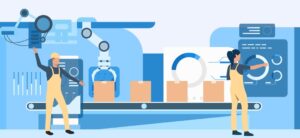Artificial intelligence is now a boardroom priority. Every enterprise wants to harness it, yet few can deploy it effectively. Many organizations are caught in the same debate: Should we invest in DataOps or MLOps first?
Both sound crucial, but timing matters. Choosing the right sequence can make the difference between an AI initiative that scales and one that stalls.
This guide breaks down what each discipline does, why they’re interdependent, and how to build a maturity roadmap that sets your organization up for long-term success.
Why This Debate Exists
Most AI projects don’t fail because of bad models, they fail because of bad data. Enterprises spend millions building sophisticated models only to discover that their data pipelines are slow, inconsistent, or unreliable.
One recent industry study found that up to 80% of machine learning project time is spent fixing or preparing data. That statistic reveals the truth without clean, consistent, and automated data pipelines, even the most advanced ML models crumble.
That’s why the “DataOps vs. MLOps” question isn’t just about tools. It’s about readiness. To deploy and scale AI confidently, you need a foundation that can sustain it and that begins with data.
Understanding DataOps: The Unsung Hero of AI Readiness
Think of DataOps as the engine room of your AI initiative. It’s the set of practices and tools that make sure data flows from source to system quickly, cleanly, and consistently.
At its core, DataOps focuses on collaboration and automation across data teams. It brings together data engineers, analysts, and business users to ensure data is not just collected, but trusted and actionable.
Key functions of DataOps:
- Data ingestion and integration: Connecting data from diverse sources databases, APIs, IoT devices, CRMs into one accessible pipeline.
- Data pipeline automation: Automating ingestion, transformation, and delivery processes.
- Data quality management: Validating data for completeness, accuracy, and timeliness.
- Monitoring and governance: Ensuring every dataset is traceable, secure, and compliant.
Understanding MLOps: Scaling Models with Confidence
Once data is reliable and accessible, the next challenge begins: scaling machine learning itself. That’s where MLOps comes in.
MLOps applies DevOps principles of automation, collaboration, and continuous delivery to machine learning workflows. It ensures that your models don’t just get deployed, but stay healthy, adaptive, and aligned with business needs.
Key functions of MLOps
- Model versioning and tracking: Managing multiple iterations of models across environments.
- Continuous integration and delivery (CI/CD): Automating the retraining, testing, and deployment process.
- Model monitoring: Tracking accuracy and drift to ensure models remain effective.
- Governance: Maintaining compliance with data and AI ethics standards.
DataOps vs. MLOps: Head-to-Head Comparison
| Aspect | DataOps | MLOps |
|---|---|---|
| Focus | Data lifecycle | Model lifecycle |
| Goal | Reliable, fast data delivery | Reliable, scalable model deployment |
| Primary Users | Data engineers, analysts | Data scientists, ML engineers |
| Key Tools | Apache Airflow, dbt, Databricks, Snowflake | MLflow, Kubeflow, Vertex AI |
| Maturity Stage | Foundational modernization | Advanced AI scaling |
| Dependency | Foundation for MLOps | Dependent on DataOps |
The relationship is clear: MLOps depend on DataOps. If your data pipelines are messy, your models will reflect that mess. But if your data pipelines are clean, consistent, and monitored, MLOps becomes a powerful growth multiplier.
The Maturity Sequencing Framework: The 3-Level AI Readiness Ladder
Here’s a simple framework to assess where your enterprise stands and what should come next.
Level 1 – Data Chaos
- Data is siloed across departments.
- Teams manually fix errors or duplicate data.
- Reports conflict because definitions vary.
Level 2 – DataOps Foundation
- Data pipelines are automated.
- Quality checks run in real-time.
- Teams share consistent, governed data sources.
Level 3 – MLOps Acceleration
- Models are deployed, monitored, and retrained automatically.
- Model performance data feeds back into DataOps systems.
- Governance ensures compliance and traceability.
Mini Checklist: Are You Ready for MLOps?
- Clean, governed, and accessible data
- Centralized pipeline management
- Clear data ownership and governance standards
- Collaborative workflows between data and ML teams
- Version-controlled datasets
If you can’t confidently tick all five boxes, your next investment should be in DataOps.
Where Should Enterprises Invest First?
The answer depends on maturity, not ambition. But for 90% of enterprises, DataOps should come first. Why? Because the success of machine learning depends on the quality and flow of data that fuels it. In a financial organization, for instance, DataOps reduced the time spent on data preparation by 60%, which allowed data scientists to focus on feature engineering and model innovation instead of pipeline firefighting.
When they later introduced MLOps, their models performed 35% better in production, because the data foundation was already strong.
Takeaway:DataOps is the multiplier of every other AI investment. It makes MLOps smoother, faster, and more reliable.
The Cost of Skipping Steps
Skipping DataOps and diving straight into MLOps is like building the roof before the foundation.
Here’s what typically happens:
- Inconsistent data breaks models. Model drift skyrockets.
- Compliance risks rise. Untracked data sources lead to audit failures.
- Engineering time is wasted. Teams spend most of their time fixing pipelines instead of innovating.
A retail company once attempted to deploy an MLOps platform before addressing data issues. Within months, their models began misclassifying customer data, leading to flawed recommendations and loss of trust from their analytics team.
The company had to pause all ML work for six months to rebuild the data layer, doubling the cost.
Lesson: No amount of MLOps tooling can compensate for weak DataOps discipline.
The Transition Playbook: From DataOps to MLOps
Here’s a step-by-step roadmap to help you move systematically from raw data chaos to full-scale AI operations.
Step 1 – Assess Your Data Maturity
Map your current data flows. Identify duplication, latency, or trust issues. Conduct a maturity audit even a simple scoring framework can highlight bottlenecks.
Step 2 – Automate Data Pipelines
Adopt DataOps tools like Airflow or dbt to eliminate manual ETL processes. Standardize data transformations so every report or model uses the same logic.
Step 3 – Enforce Data Governance
Define ownership, access, and validation rules. Make governance a built-in part of the data lifecycle, not an afterthought.
Step 4 – Integrate MLOps Workflows
Once your data foundation is stable, integrate MLOps tools like MLflow or Vertex AI. Enable continuous training and deployment pipelines.
Step 5 – Monitor and Optimize
Use shared dashboards for data quality and model performance metrics. Establish a feedback loop every insight from MLOps should refine DataOps.
Tip: Treat this as a relay race, not two separate sprints. DataOps hands off clean, contextualized data to MLOps and MLOps sends back insights that strengthen DataOps.
Real-World Examples of Successful Sequencing
Retail – Building from the Ground Up
A leading retailer unified data from online, in-store, and warehouse systems using DataOps. Once data pipelines stabilized, MLOps helped automate price optimization. Revenue per SKU improved by 12% within six months.
Manufacturing – Predictive Maintenance
By implementing DataOps for sensor standardization, a manufacturing firm achieved consistent time-series data. Later, MLOps automated predictive maintenance models, cutting downtime by 30%.
Banking – Faster Fraud Detection
A global bank cleaned up customer data pipelines with DataOps first, reducing latency from 48 hours to near real-time. When they layered MLOps, fraud detection accuracy improved by 25% with fewer false positives.
Pattern: Every success story starts with DataOps and scales with MLOps.
Bringing It All Together
Let’s simplify the choice:
- DataOps ensures trust and speed.
- MLOps ensures scale and sustainability.
The best AI-driven enterprises integrate both, but they start with data discipline. Because when your data foundation is strong, your models are not just accurate, they’re adaptable.
If you’re unsure where your organization stands, start with a DataOps readiness assessment. It’s the fastest way to unlock meaningful AI value without overspending on premature tooling.
Conclusion
By 2026, enterprises that master both DataOps and MLOps will deliver AI outcomes three times faster than those that treat them as separate silos.
But speed alone isn’t the differentiator, resilience and adaptability are. Organizations that invest first in DataOps build a foundation of clean, connected, and trusted data. When MLOps enter the picture, those same enterprises don’t just deploy models, they scale them confidently, govern them intelligently, and evolve them continuously.
Skipping DataOps is like trying to automate chaos. But sequencing it right DataOps first, MLOps next creates a flywheel of AI value where insights improve operations, and operations fuel smarter insights. That’s how data-driven enterprises move from experimentation to excellence.
Want to accelerate your AI maturity? Connect with our experts to design your DataOps-to-MLOps roadmap and make your AI initiatives truly enterprise-ready.




